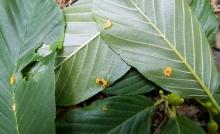See:
Oats (Avena sativa) - Crown Rust
Cause Several different fungi can cause leaf spots on cascara (sometime called buckthorn and formerly Rhamnus purshiana).
Marssonina rhamni, Coniothyrium rhamnigenum (formerly Phyllosticta rhamnigena), and Septoria blasdalei have been reported from Washington. The fungi overwinter in fallen leaves. They produce spores in spring in rainy weather, which also favors infection. More spores produced in the first lesions can produce new infections on healthy leaves.
Rust, caused by Puccinia coronata, also has been reported in the PNW. Alternate hosts for this rust are cultivated oats and several wild grasses such as velvetgrass, bluejoint, western bentgrass, and ryegrass.
Symptoms The spots caused by these fungi are similar in appearance and can be distinguished only by microscopic examination of the fruiting bodies and their spores. The spots are gray-to-brown and circular to irregular in shape. The fruiting bodies are produced on the upper surface of the leaf and can usually be seen as minute dots in the center of the spots.
Rust - Yellow to orange-yellow fruiting bodies are formed on the underside of leaves. The individual fruiting bodies are cup shaped and closely grouped together into what is called a cluster cup. The leaf tissue bearing the cluster cups becomes somewhat thickened and distorted and eventually dies.
Cultural control
- Rake and destroy fallen leaves.
- Avoid overhead irrigation or any practice that keeps plants wet for extended periods of time.
Chemical control No chemicals are specifically registered for this plant.
Reference Shaw, C.G., and Harris, M.R. 1960. Important diseases and decays of trees native to Washington. Ag Extension Service, WSU. Extension Bulletin 540.


